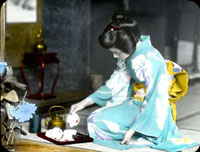 Wu wei (non-action) is a natural movement without efforts. During many years Tea has gone through a long process of the evolution of simplification in which all the unnecessary repetitions and show movements were removed.
Wu wei (non-action) is a natural movement without efforts. During many years Tea has gone through a long process of the evolution of simplification in which all the unnecessary repetitions and show movements were removed.
Talking about plastics and movements peculiarities, one can say that every movement in a Tea Ceremony was definite and fixed like in choreography. Each time when Tea is being prepared ritual movements are being repeated. There are many variations depending on the season and objects used during ceremony. While repeating we learn to feel and perceive these movements. Such repetitive movement perceiving resembles reading excellent poems, whose meaning grows and changes every time we read them. Key moments of the ceremony cannot be singled out from the process of preparing Tea as main moments, because separate movements have to make a sole process. At the same time we are as bound by the rules of preparing Tea as by rules of grammar when we are writing a text. There is no code we need to follow. A teacher doesn’t give strict rules to be followed blindly but invites pupils to share the awareness of being natural and indispensable. During Tea Ceremony nobody reaches anything. You have to let a Tea Ceremony though your emotional experience. When a beginner let his tension and concentration on ‘right’ and ‘wrong’ actions go, the process stats to develop independently and natural.
A teacher doesn’t give strict rules to be followed blindly but invites pupils to share the awareness of being natural and indispensable. During Tea Ceremony nobody reaches anything. You have to let a Tea Ceremony though your emotional experience. When a beginner let his tension and concentration on ‘right’ and ‘wrong’ actions go, the process stats to develop independently and natural.

